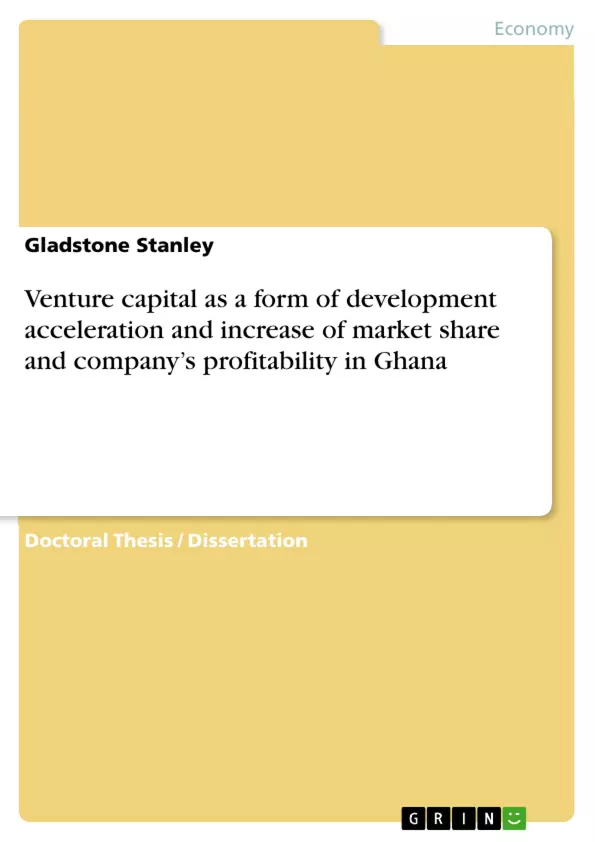This study focuses on 2006-2016 and aims at assessing the contribution of the venture capital trust fund on the operation of the beneficiary SMEs in the area of financial management, corporate governance, profitability and market shares. Using purposive sampling method, all the 27 SMEs benefiting from the Venture Capital Trust Fund were interviewed to appreciate the issues surrounding the use of venture capital for effective recommendation. The agro processing, real estate, health care and hospitality sector administered 11,11% each of the questionnaires, the education sector administered the highest questionnaires representing 22,22%,pharmaceutical manufacturing, manufacturing and financial sector administered 7,41%, Beverage Manufacturing and Industrial Consumables & Services administered 3,70% each.
SMEs are the bane of every country especially Ghana. They are major contributor to employment, wealth creation, poverty reduction, taxation, Gross Domestic Product, foreign exchange earnings and development and innovation of new business ideas. However, SMEs are saddled with financial constraints, poor corporate governance and financial management, limited market share and encounter losses in business operation. The SMEs also lacks collateral securities to acquire loan from financial institutions to employ the needed human resource and equipment for startup capital and growth. Those that had the collateral securities and acquire the loans are faced with high interest rate which increased their cost of business hence low return for expansion.
Inhaltsverzeichnis (Table of Contents)
- 1. INTRODUCTION
- 2. VENTURE CAPITAL AS DEVELOPMENT ACCELERATION, INCREASE OF MARKET SHARE AND COMPANY'S PROFITABILITY
- 2.1 Venture Capital
- 2.1.1 Definition of Venture Capital
- 2.1.2 Characteristics of Venture Capital Concept
- 2.1.3 What Venture Capital Expect
- 2.1.4 The Venture Capital Investment
- 2.1.5 Financing Stage of Venture Capital
- 2.1.5.1 Venture Capital versus Private Equity
- 2.1.5.2 Type of Investee Firm
- 2.1.5.3 Use of Proceeds by Investee Firms
- 2.1.5.4 Type of Risk
- 2.1.6 Venture Capital Funding
- 2.1.6.1 Clear-Cut Policy and Regulatory Framework
- 2.1.7 History of Venture Capital
- 2.1.8 Growth of Venture Capital
- 2.1.8.1 Venture Capital in Europe
- 2.1.8.2 Venture Capital in Africa
- 2.1.8.3 Venture Capital in Ghana
- 2.1.9 Summary
- 2.3 Definition and Overview of SMEs in Ghana
Zielsetzung und Themenschwerpunkte (Objectives and Key Themes)
This dissertation thesis examines the role of venture capital in accelerating the development and increasing market share and profitability of small and medium-scale enterprises (SMEs) in Ghana. The study aims to assess the contribution of the Venture Capital Trust Fund to the financial management, corporate governance, profitability, and market share of beneficiary SMEs.
- The impact of venture capital on SME growth and development in Ghana
- The contribution of venture capital to financial management and corporate governance practices of SMEs
- The relationship between venture capital investment and the profitability and market share of SMEs
- The challenges and opportunities associated with venture capital in Ghana
- Recommendations for fostering a vibrant venture capital ecosystem in Ghana
Zusammenfassung der Kapitel (Chapter Summaries)
Chapter 1 introduces the topic of venture capital and its relevance to SME development in Ghana. It provides a background on the SME sector in Ghana and highlights the challenges faced by SMEs in securing funding and achieving sustainable growth. Chapter 2 delves into the concept of venture capital, defining its characteristics, expectations, and investment stages. It discusses the historical development of venture capital, exploring its growth in Europe, Africa, and specifically in Ghana. Chapter 3 focuses on the definition and overview of SMEs in Ghana. It analyzes the role of SMEs in the Ghanaian economy, their contributions, and the factors that influence their performance.
Schlüsselwörter (Keywords)
Venture capital, SME development, Ghana, financial management, corporate governance, profitability, market share, Venture Capital Trust Fund, SMEs, asset turnover, average profit, average sales, return on asset, value of net asset.
- 2.1 Venture Capital
- Arbeit zitieren
- Gladstone Stanley (Autor:in), 2018, Venture capital as a form of development acceleration and increase of market share and company’s profitability in Ghana, München, GRIN Verlag, https://www.grin.com/document/461955



